How to Maintain Brand Compliance in Today's World
This article originally appeared on the Intelligencebank Blog and we think our reader will find it useful.
When brands assess risk and how that might impact their ongoing business, brand compliance is a consistent concern. Companies spend eye-watering portions of their marketing budgets building brand equity, yet a lack of consistency, unapproved content or activity which isn’t aligned to the companies values can destroy this in minutes.
An online brand portal makes it easy to keep your team on brand by centralizing creative & managing brand compliance with workflows, approvals and online brand guidelines. Managing brand compliance from a design, legal and regulatory compliance perspective is critical for anyone serious about developing brand equity and value over time.
So, how do the world’s leading marketers showcase their online guidelines while maintaining brand consistency and compliance?
Bring Your Brand To Life
Showcase brand guidelines, educate and inspire your team for greatness.
Most businesses have spent time and money developing a beautiful set of brand guidelines. Yet, the problem is they are displayed in PDF format and stored on a shared drive. They may be reviewed a couple of times, but rarely as an ongoing part of the creative development process.
PDF guidelines are typically difficult to access, hard to interpret and are often ignored. The result is that the brand team needs to spend considerable time fielding repetitive questions and checking, then rechecking work against brand standards. Also, by having document-based brand guidelines means that multiple versions can be in circulation at any time and the wrong version is constantly used.
The first step in achieving brand consistency is to take your guidelines online, making them on-demand and easily accessible to your team, agencies and other stakeholders. A permission-based, online brand portal enables you to bring your brand to life by showcasing brand guidelines and best practice examples. By integrating a virtual approach, it’s as though your brand has a live Q&A capability.
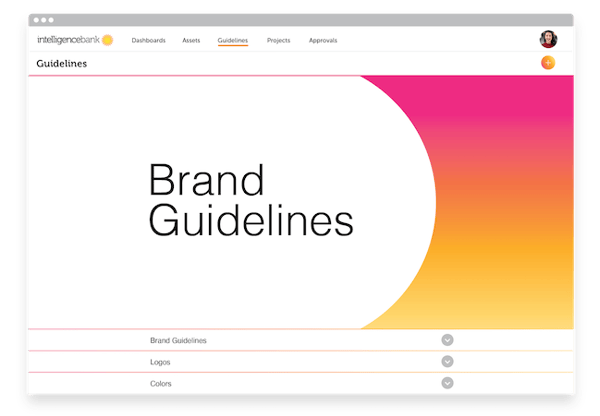
Online brand pages are not only essential in achieving brand buy-in from the rest of the business but make maintaining and updating your brand a simple process. Multiple versions are no longer a problem as updates made online are instant. Portals are easy to manage and can be as simple as using easy to update templates, or using custom designs which look and feel like an extension of the brand website.
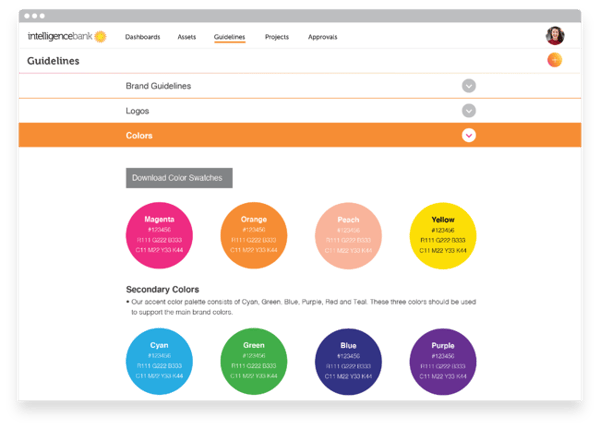
Control Branded Content
Control assets with expiration dates, use AI and facial recognition to tag files and instantly report on ROI and usage.
Digital assets make up the foundation of marketing activity. They are more than just a logo or typeface. They also include images, videos and files used every day and are the essence of any brand.
If your brand doesn’t have a single place to store and manage these assets, there is a risk of your team using low quality and off-brand assets. Without a dedicated platform, it is impossible to practice consistency across your marketing efforts.
Having a centralized location to store and manage brand assets and approved content enables your marketing team to be on the same page. It ensures that you aren’t purchasing the same content multiple times and gives you a place to manage usage rights.
A Digital Asset Management System (DAM) allows you to take back control. It is a scalable online solution for managing your files/brand assets and distribution and works hand in hand with your online brand guidelines.
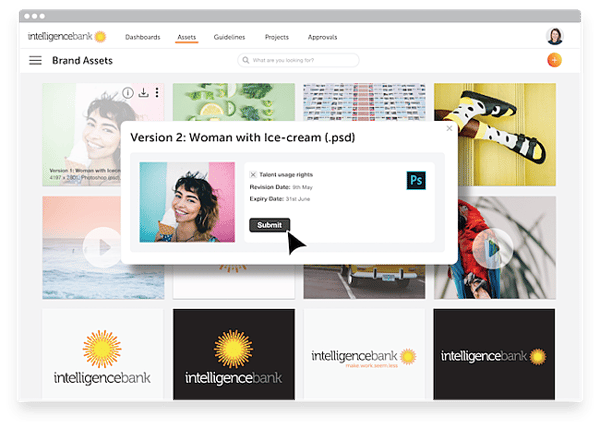
Go With The Flow
Workflows let you streamline content requests and approve final creative.
Managing and tracking marketing content is difficult without a proper approvals system in place. And, not having an audit trail of what was checked by 'whom' and 'when' can lead to both inconsistent and non-compliant materials. To safeguard your brand having basic workflow and approval systems in place is essential.
Simple workflow and approval processes for content include talent usage rights, new creative or download requests for branded assets. You don't need to have complicated workflows to start, but what's important is that you have control over how your brand is being used.
By using an automated system you are not only able to ensure brand governance but are also able to introduce efficiencies into your marketing team, cutting back on day-to-day admin.
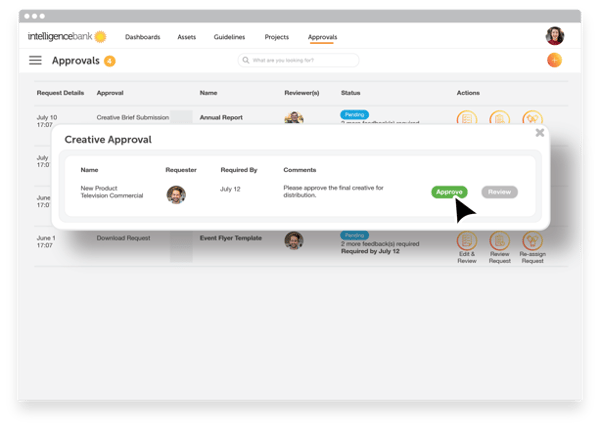 Distribute Content Quickly
Distribute Content Quickly
Transform, crop and resize images and video on the fly and embed links directly from your DAM.
Having a way to share correct branded content, quickly, is necessary when operating in today’s fast-paced marketing environment. For many teams, this can be a problem as speed and approvals typically don’t work hand in hand. Where content is used in multiple places and in a range of formats, individual approvals aren’t a reality. This, however, can be achieved when using a robust DAM.
Approved content can be uploaded to the DAM and then transformed from within the system. Users can transform, crop, or compress images and videos, then download multiple versions all within a few clicks of the mouse. Or, where assets are being used online, they can be shared directly using Content Distribution Network (CDN) links.
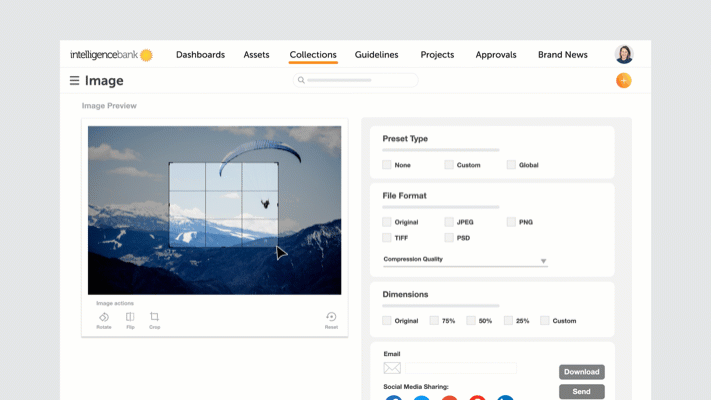
Sharing content in such a way means that local copies aren’t kept on marketer’s computers, content can be tracked and where updates are required they can be made instantly across the web.
Automate Brand Communications
With custom templates, ensure local marketing is consistent and on-brand.
Creative templates are a great tool for marketers looking to maintain brand consistency as well as those looking for increased efficiencies. They allow teams to replicate pre-approved content, making minor adjustments, quickly and seamlessly without the need for additional design resources. They also allow local teams to customize creative content within set parameters. This means that all brand elements remain intact, as well as high-risk information such as terms and conditions while allowing users to edit specific text or images.

Reduce Brand Admin
A dedicated ‘brand inbox’ enables your team to self-serve logos and other requests saving you over 20% of time.
An online brand portal is key to ensuring that your brand assets are made available to your team and stakeholders, but also that they are being used correctly. Digital Asset Management - as well as online brand guidelines - instruct on how your brand should be used, but also allow users to self-serve the correct and approved brand assets.
While this is the key to ensuring that your logo isn’t just taken from Google, many brands go a step further in helping their staff and agencies correctly use their brand. A ‘brand inbox’ helps by allowing users to contact the brand team to directly ask for access to approved assets. When the most common questions are asked, the ‘brand inbox’ automatically directs them to the answer or assets they need. Yet - when a more complex answer is required, it puts them in touch with the relevant member of the marketing team.
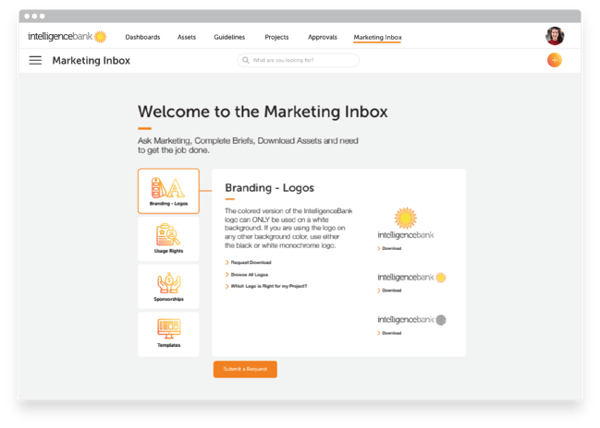 To learn more about how Digital Asset Management, BrandHub or Creative Templates can help your marketing team ensure brand compliance and increase marketing efficiency, contact us.
To learn more about how Digital Asset Management, BrandHub or Creative Templates can help your marketing team ensure brand compliance and increase marketing efficiency, contact us.
About Intelligencebank
IntelligenceBank marketing operations software helps content marketers seamlessly manage digital assets, creative content approvals and compliance, and creative project management. Our beautifully designed software is used by over 400 brands globally. We offer 24/7 support with offices in the US, Australia, and Canada.


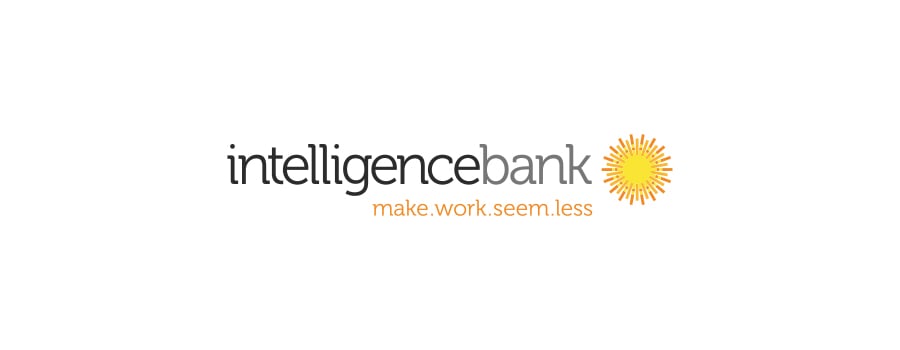






 ioi blog
ioi blog ioi events
ioi events ioi newsletter
ioi newsletter